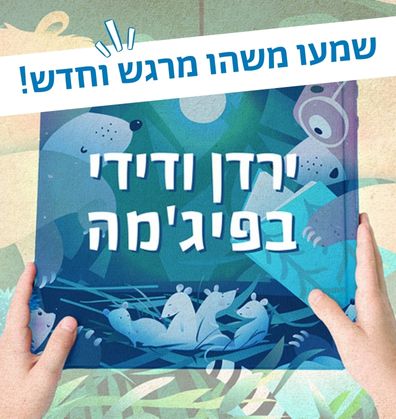מִשְׁפָּחָה וּקְהִלָּה
בית
ספרים יפים ומגוונים מחכים לספר לכם על הבית שבחוץ ועל הבית שבלב, על הסביבה הקרובה המוכרת לילד וגם על זו הרחוקה יותר, על תחושה של בית ועל משפחה שגרה בבית, על שייכות ועל זהות.
סְּפָרִים
Book-Related Family Activities

מעברים
תוכלו לשתף את הילדים בחוויות ממעברים שחוויתם בעצמכם, או להיזכר יחד במעבר משותף. אפשר לשאול את הילדים איך לדעתם הרגישה הילדה כשהגיעה בפעם הראשונה לבית הנמוך, איך הם היו מרגישים בִּמקומה, ומה היו אומרים לה לוּ פגשו אותה.
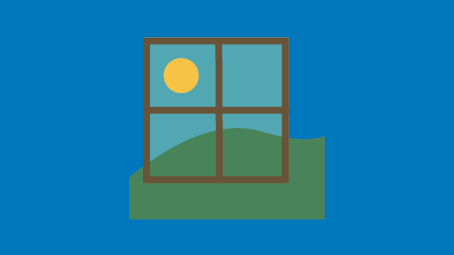
טיול בעקבות בעלי חיים
אפשר לעשות סיבוב קצר ליד הבית, בשעות היום או הערב, לשמור על שקט ולשים לב – האם אנחנו רואים בעלי חיים בסביבה? האם אנחנו שומעים קולות מיוחדים? מה ההבדל בין בעלי החיים שאנחנו רואים ושומעים ביום, לבין אלה שיוצאים בלילה?

לצייר לנו בית
ציירו יחד בית, כשכל אחד מוסיף חלק לציור. תנו חופש לדמיון וליצירתיות, בבית הזה הכול אפשרי. אולי בבית שלכם יהיו חלונות בצורת כוכבים? ואולי דלת מפרחים? או אפילו מגלשת מים מהגג! כשתסיימו תוכלו לדמיין יחד איך יהיה לגור בבית החדש שיצרתם.

האזינו לסיפור "הבית הגבוה והבית הנמוך"
האזינו לסיפור “הבית הגבוה והבית הנמוך” בהסכת “ספריית פיג’מה קוראת לכם”.

A discussion on our house
All houses consist of walls, a roof, doors and windows: What’s special about your house? What makes it your home? You may want to discuss special objects and items found in your home, or the things you do there together.
A video – House of boxes
What can you do in a house made of boxes? Scan to QR code to get ideas for a house that’s both real and imaginary.
Arts & crafts – Home building
How about making a house out of blankets, cardboard boxes, sticks and clothespins? And what else would you need? Decide on a location and workplan, gather the necessary items and accessories, and off you go!
A game of house catch
Take turns announcing a topic and having all the other players try to work together to find a suitable item. For instance, when “red” is announced, all players must search the house for a red item. In the next round, another player might call out “big”, “small”, “cute”, “old”, “multicolored”, “annoying” or “wheel”, sending the other players to look for an item matching their announced topic.
פינטרסט
Pinterest
Arts & crafts, songs and other activities are available on the Sifriyat Pijama Pinterest
Discussion
How many rooms does your house have? And what do you do in each one? You may want to look around and think: What do we really need, and what could we forego? You could discuss your own home, or imaginary ones. You parents could tell your children about the house in which you lived when you were their age: What are the differences and similarities between your childhood home and the current one?
Building houses
You can be builders too! You can build a house of Legos, cardboard boxes, pillows, or any other material. How about decorating the structure you’ve built, and asking your parents to help you write the name of the street it’s on. And who would you want to invite over to the house you’ve built?
An illustrated story
You may enjoy looking at the illustrations and discovering the other houses that appear in them: Who is building a house? And who is carrying one on their back?
One room
Look at the final illustration at the end of the book, where the main character is living in a single room: Which items does it contain? Would you have removed any of them, and brought in others in their stead? Which items found in your home would you have added to the room depicted in the illustration? You could take turns and have each family member pick an item in the illustration and decide whether or not they would leave it in the illustrated room, and if not, which item from your own home they would have placed there instead.
Proposed Family Activities:
- You may like to read the story together, look closely at the illustrations, and pay attention to all the little details they provide. You may enjoy finding the father and dog who are accompanying the little boy on every page. Did you find any of the illustrations amusing? Did you guess where the little boy was headed?
- Just around the corner from Grandma’s house, the little boy starts counting to ten. You may enjoy searching for the digits the illustrator hid among the pages. Did you notice a match between the number of items in the illustration and the number the boy says? Can you count how many pigtails the little girl has? Or how many birds she feeds? And how many cats are being sold?
- In the illustration depicting grandma’s house, what do we see as the door opens? What and who are waiting for the little boy? You could ask your child what they think the little boy will be doing while at his grandmother’s house. What would he eat? What and who would he play with? You may want to use puppets to act out the encounter between the boy and his grandmother, and add another page or two to the story.
- Perhaps you would enjoy going for a walk outside your own home and taking a fresh look around: what does your own front door look like? And the handle? Do you also have a road behind your door? Go outside, stand still for a minute and listen. Can you hear the cars going past? Birds tweet, or cats meow? What do you smell? Who do you see? You could also play a guessing game, taking turns to describe a sight or sound encountered on the way, while the other tries to guess what it is.
- On the final page of the book is a heart-shaped map of the route from the little boy’s house to his grandmother’s. Perhaps you would also enjoy drawing such a map, be it heart-shaped or otherwise, of the way from your house to kindergarten.
- Sometimes we cannot walk to our grandmother’s house, to a close relative or much-loved friend, because they live too far away. How, then, do we keep in touch with them? You may want to think together of ways of keeping in touch – telephone calls, sending photos or videos, letters and greeting cards.
You are welcome to leaf through the book
You are welcome to leaf through the book, and look at Lena Guberman’s unique illustrations closely. Make sure you read the words and signs in the illustrations too! Has anything about the illustrations made you laugh? They are all made of colorful fabrics, thread, and wool. Perhaps you would also like to look for a piece of cloth or an old sock, cut it up, glue or sew it together, to make your own special artwork.
You may want to discuss the Haruvis' demand for quiet, and their neighbors' responses with your child
You may want to discuss the Haruvis’ demand for quiet, and their neighbors’ responses with your child. Have you ever been asked to change your habits in order to be more considerate of others, such as family members or neighbors? Did that request seem reasonable or over the top? Having read the story together, you may be reminded of your own neighbors. Who have you not seen in a while, and would like to invite over to your house?
Perhaps you would like to take a walk around the neighborhood
Perhaps you would like to take a walk around the neighborhood. What does it look like? Who are your neighbors, and do you know them all? Do you spend time together, or help each other out? You may want to draw or make a model of your neighborhood together, and add those who live in each apartment or house.
Would you like to play "silence"?
Would you like to play “silence”? You’re welcome to whisper to one another, play in silence, walk on tiptoes, eat quietly, and even try to laugh without making a sound. Would you have passed the Haruvis’ “quiet neighbor test”?
You may enjoy discussing the following with your family or sharing it with your neighbors:
You may enjoy discussing the following with your family or sharing it with your neighbors: Does anything require improvement or repair in your shared space? You could initiate some neighborhood activities, such as decorating the shared stairwell, planting a community garden, or helping one another in your community. Put together an action plan, and get started.
Laughter is an easy and fun way of coping, it makes you happy, and can even be contagious
Laughter is an easy and fun way of coping, it makes you happy, and can even be contagious. Perhaps you would like to try laughing while making every possible sound: Hoo hoo hoo, Ho ho ho, Ha ha ha, He he he, Hee hee hee. Start laughing and change sounds each time. Did your laughter “roll and tickle”? Did it lift your mood?
Activities You Can Do at Home
- Amy and Louis became friends because they were neighbors who enjoyed the same things, so when Amy moves far away, she’s faced with a big challenge. Talk with your children about how you manage to keep in touch with faraway friends and family. After you finish reading this story, your children might get in touch with people they miss: they could write or draw a letter to send them, or talk to them via phone or the Internet.
- Amy and Louie don’t merely miss each other; they recall the things they used to do together. You might talk with your children about things we can do to help keep memories alive. If you have photos, letters, or other items that remind you of friends and shared experiences from your past, you could share them with your children.
- Children are introduced to this book near the end of their kindergarten year. You could talk with your children about good-byes, transitions, and new beginnings. Maybe talk about the friends they’ve made in kindergarten and the things your children like to do with them. Your children could also draw pictures or write letters to give to a friend, teacher, or other staff member at the kindergarten, as a memento.
- Have you ever traveled to a foreign country, “half a world away?” Do you, like Amy and Louis, have friends who live in a faraway land? Using a globe or an atlas, you could show your children the countries you’ve visited or the places where your friends and family live. You could also explain time differences, intercontinental travel, and much more. “Amy and Louis” is the final book in PJ Library’s list for the year. We hope you have enjoyed these books and send you our best wishes for a successful summer and transition to kindergarten and beyond. Please keep in touch!

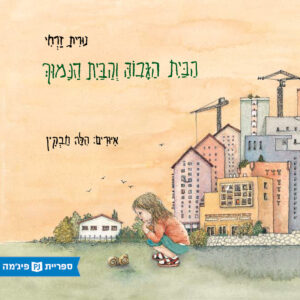 The Tall House and the Short House
The Tall House and the Short House 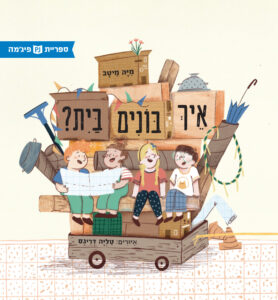 How to Build a House
How to Build a House 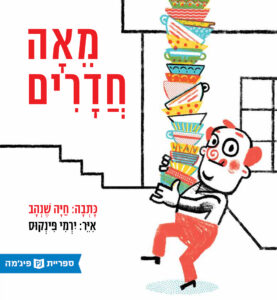 One Hundred Rooms
One Hundred Rooms 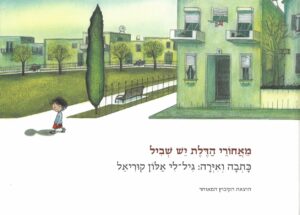 Behind the Door
Behind the Door 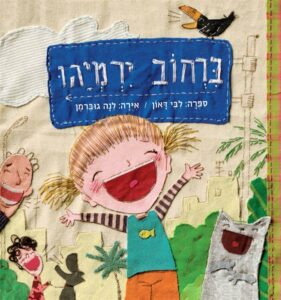 Yirmiyahu Street
Yirmiyahu Street 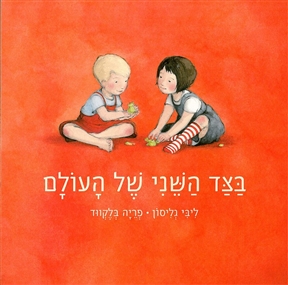 Amy and Louis Hebrew title: “Half A World Away”
Amy and Louis Hebrew title: “Half A World Away” 

